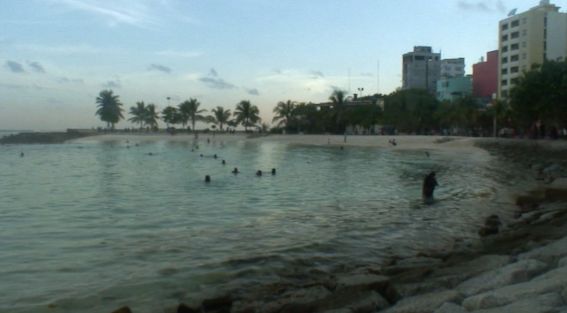
Still from The Free Sea. Underwater sounds, entangled with grainy voices from a TV recording; an assemblage of TV footage, of handheld camera, satellite view, computer animation, speech, text – a filmic essay framed by the vast sea.
This multi-facetted video essay focuses on the hypothetical disappearance of the Maldives, the island country in the Indian Ocean that often plays the part of just another faceless vacation paradise in the western imagination. These sunny islands that might be swallowed by the sea in a hundred years due to rising sea levels, due to anthropogenic climate change.
The Free Sea is in many ways symbolic of Hanna Husberg’s artistic production: it’s usually these areas her artwork inhabits, the troublesome barrier between the human and the non-human, between culture and nature. This same diffused limit is also the domain of what we call the Anthropocene, the – albeit often contested – term for the geological era we live in, the geological epoch when humankind has become a primary actor in shaping the earth’s climate, when nature itself has become human-centred.
How did you decide to use the Maldives as a topic for The Free Sea?
“It all started during the Venice Biennale about two years ago, when I participated in the Maldivian pavilion. There were a number of events arranged in conjunction with the pavilion, and the film was a way to think through the whole project. It developed as a website, which I worked on together with Laura McLean, a curator based in London”
“My practice is usually pretty installation-centred. It mainly deals with how we humans relate to our environment. Before the Maldives-project, I hadn’t really done anything as place-specific as this. And I think it was an interesting project for me, to work in a concrete place. For through this concrete place many important issues arose.”
And the hypothetical disappearance of the Maldives certainly ties together many different issues – the political, ecological, economic, cultural and historical all come together in the film. The title The Free Sea originally refers to a book by 17th century thinker Hugo Grotius, Hanna explains, in which he suggests making the sea into an international free trade zone. In a way key step towards what we today refer to as globalization, also a key component of the anthropocene.
“I’m pretty interested in how different things are connected, it’s where I very much do my work. This is especially pertinent when dealing with climate change, a lot of seemingly unconnected things are put together. And that’s where I try to untangle a bit, in my own way of course. At the moment I’m working on a project on air and atmosphere – as something that is very local and very global at the same time.”
Due to its increasing ecological relevance and inherent political dimension, the topic of the anthropocene has become quite a popular theme in contemporary art. But as a concept it remains problematic.
“[The anthropocene] is interesting, it blurs definitions a bit. But a problem also lies in defining who this anthropos is, who constitutes this humanity. Some people play a bigger part in climate change.”
”It’s primarily materiality that interests me, how dualisms are broken down, because they are very strong in western thought, the distinction of nature/culture, the human/non-human, the object/subject and so on. And its becoming clearer and clearer that it doesn’t work that way.”
Continuing with the political and paraphrasing the philosopher Alain Badiou, who views art as always being in resistance to something, would you define your art as a form of resistance?
”I don’t know if it’s about resistance or fighting against something, more of making things visible. Concretely I’ve always found questions about the climate to be difficult. And I often think about how I relate to all this. It’s been difficult with all the loud and gaudy newspaper headings, and thus I’ve tried to figure out my own way to deal with it, in a more embodied way.”
